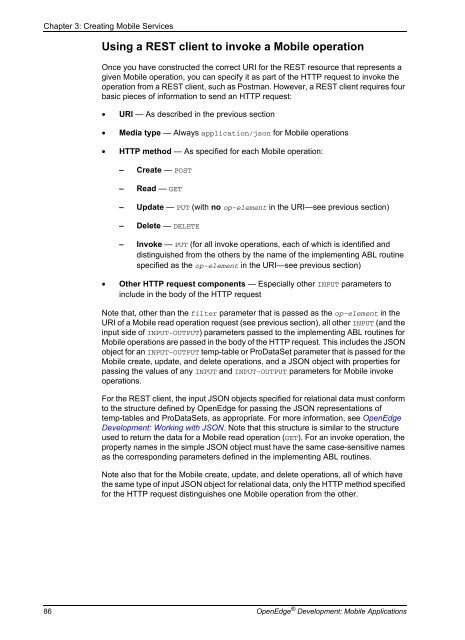OpenEdge Development: Mobile Applications - Product ...
OpenEdge Development: Mobile Applications - Product ...
OpenEdge Development: Mobile Applications - Product ...
Create successful ePaper yourself
Turn your PDF publications into a flip-book with our unique Google optimized e-Paper software.
Chapter 3: Creating <strong>Mobile</strong> Services<br />
Using a REST client to invoke a <strong>Mobile</strong> operation<br />
Once you have constructed the correct URI for the REST resource that represents a<br />
given <strong>Mobile</strong> operation, you can specify it as part of the HTTP request to invoke the<br />
operation from a REST client, such as Postman. However, a REST client requires four<br />
basic pieces of information to send an HTTP request:<br />
• URI — As described in the previous section<br />
• Media type — Always application/json for <strong>Mobile</strong> operations<br />
• HTTP method — As specified for each <strong>Mobile</strong> operation:<br />
– Create — POST<br />
– Read — GET<br />
– Update — PUT (with no op-element in the URI—see previous section)<br />
– Delete — DELETE<br />
– Invoke — PUT (for all invoke operations, each of which is identified and<br />
distinguished from the others by the name of the implementing ABL routine<br />
specified as the op-element in the URI—see previous section)<br />
• Other HTTP request components — Especially other INPUT parameters to<br />
include in the body of the HTTP request<br />
Note that, other than the filter parameter that is passed as the op-element in the<br />
URI of a <strong>Mobile</strong> read operation request (see previous section), all other INPUT (and the<br />
input side of INPUT-OUTPUT) parameters passed to the implementing ABL routines for<br />
<strong>Mobile</strong> operations are passed in the body of the HTTP request. This includes the JSON<br />
object for an INPUT-OUTPUT temp-table or ProDataSet parameter that is passed for the<br />
<strong>Mobile</strong> create, update, and delete operations, and a JSON object with properties for<br />
passing the values of any INPUT and INPUT-OUTPUT parameters for <strong>Mobile</strong> invoke<br />
operations.<br />
For the REST client, the input JSON objects specified for relational data must conform<br />
to the structure defined by <strong>OpenEdge</strong> for passing the JSON representations of<br />
temp-tables and ProDataSets, as appropriate. For more information, see <strong>OpenEdge</strong><br />
<strong>Development</strong>: Working with JSON. Note that this structure is similar to the structure<br />
used to return the data for a <strong>Mobile</strong> read operation (GET). For an invoke operation, the<br />
property names in the simple JSON object must have the same case-sensitive names<br />
as the corresponding parameters defined in the implementing ABL routines.<br />
Note also that for the <strong>Mobile</strong> create, update, and delete operations, all of which have<br />
the same type of input JSON object for relational data, only the HTTP method specified<br />
for the HTTP request distinguishes one <strong>Mobile</strong> operation from the other.<br />
86 <strong>OpenEdge</strong> ® <strong>Development</strong>: <strong>Mobile</strong> <strong>Applications</strong>
















